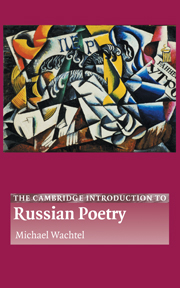Book contents
- Frontmatter
- Contents
- Preface
- Acknowledgments
- Note on translations and transliterations
- Introduction
- Part I Concepts
- Chapter 1 Versification: how to do things with words
- Chapter 2 Poetic language
- Chapter 3 Tradition and the individual talent
- Part II Interpretation
- Conclusion: poetry and pattern
- Bibliography
- Suggested further reading
- Index of poetic terms
- Index of names and works
Chapter 3 - Tradition and the individual talent
Published online by Cambridge University Press: 05 June 2012
- Frontmatter
- Contents
- Preface
- Acknowledgments
- Note on translations and transliterations
- Introduction
- Part I Concepts
- Chapter 1 Versification: how to do things with words
- Chapter 2 Poetic language
- Chapter 3 Tradition and the individual talent
- Part II Interpretation
- Conclusion: poetry and pattern
- Bibliography
- Suggested further reading
- Index of poetic terms
- Index of names and works
Summary
Всё бы́ло вста́рь, всё повтори́тся сно́ва,
И сла́док на́м лишь узнава́нья ми́г.
Мандельштам, «Tristia»Everything was before, everything will repeat again,
And for us only the moment of recognition is sweet.
Mandelshtam, “Tristia”In any sphere of creativity, an unspoken directive to “make it new” coexists with an equally strong tacit imperative to retain qualities of the old. Pure repetition is tedious; pure innovation is incoherent. To see how traditions evolve, one need look no further than the local movie theater. Seventy years ago, audiences flocked to “King Kong,” quaking in their seats as the eponymous beast screamed, raged, and took on New York City. Today's viewers may admire this same film as a historical document, but few will react with the gasps and screams that the film originally aroused. In particular, the special effects, so daring in their day, now contribute more to mirth than to fear. Producers of the latest monster films rely on myriad technical advances to shock a generation inured to cinematic horror, yet they generally preserve the basic plot outline of a wild creature's encounter with civilization. Many retain the love subplot and even specific details, like the monster's appearance at or on top of famous buildings or a “bad guy” becoming one of its victims. Such repetitions reflect less a lack of creativity than a genuine insight: what worked well once can work well again. Consciously or not, the audience itself wants to be terrified only within familiar parameters.
- Type
- Chapter
- Information
- The Cambridge Introduction to Russian Poetry , pp. 50 - 62Publisher: Cambridge University PressPrint publication year: 2004

